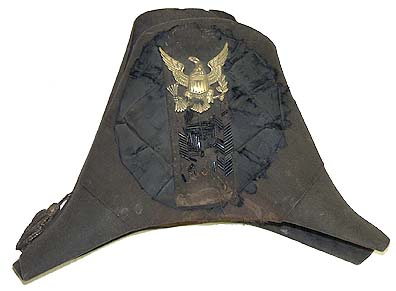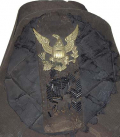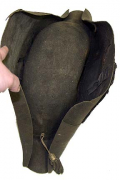site search
online catalog
MAKER MARKED AMERICAN MILITARY OFFICER’S CHAPEAU CA. 1825-1835

$1,750.00
Originally $2,450.00
Quantity Available: 1
Item Code: 413-01
Shipping: Determined by Method & Location of buyer
To Order:
Call 717-334-0347,
Fax 717-334-5016, or E-mail
This scarce American military officer’s chapeau has a largely intact white silk lining bearing a black maker’s stamp reading “C. St. JOHN. / 118 / BROADWAY, New York.” Bazelon places Charles St. John with a hat store at 116 Broadway in 1823-24 and then in business with Mathew C. St. John as hatters at 118 Broadway from 1824 to 1837, with Charles dropping out that year and leaving New York City by 1839, returning only in 1851 to operate for a time at a different address and then pursue other businesses. Mathew C. St. John in the meantime had continued in business and a similar example bearing only his name at the old address can be seen in Howell and Kloster (Smithsonian publications,) once worn by McClellan as a lieutenant of Engineers, that corps having adopted this pattern of chapeau in 1840. All of that pretty firmly dates this one prior to 1840, likely before 1837, and perhaps much closer to 1824, when the two St. Johns were just setting up business together at that address, since it bears on Charles’s initial.
Following European military fashion of the Napoleonic Wars, bicorne hats had replaced the old tricorne configuration in the American military around 1790. By the war of 1812 they were largely worn only by field grade and staff officers with the exception for a time of the artillery. This fits the style later adopted in the 1832 pattern with a less uniform curve- the top somewhat exaggerated and the sides sloping steeply to spread out only toward the very bottom. This follows the pattern in showing wide black silk ribbons starting about halfway down each side at an angle to touch at the bottom center front. A large black silk cockade is in place, taking up much of the front center of the hat. Over this a black “loop” descends from the top center, on which is mounted a stamped brass eagle with raised wings, its head turned slightly up and to the left, with a U.S. shield on its chest and clutching an olive branch and arrows. A separate, swirling E Pluribus Unum ribbon was likely in place above it, with both brass elements gilt.
More extravagant versions with gilt loops and silver eagles with gold rays and silver stars were specified for generals, with further rank distinction made by the color and number of feathers in the plume. This follows the pattern allowed for field officers of line regiments when not serving with troops, in having the loop be of black silk rather than embroidered gold bullion. The hats would have bullion tassels showing at either side, the color to be determined by the branch of service metal color, which would also be displayed on the appropriate button at lower center of the loop. When the Corps of Engineers was established in 1838, it was given its own uniform in 1839, and authorized the same form of chapeau, though with a plain gold lace loop in February 1840, resulting in it being called the 1840 Pattern, but more in terms of its date of adoption by the Engineer Corps than a specific new style of hat. The chapeau was not specified in the 1851 regulations, but generals, regular and brevet, were permitted to wear them on ceremonial occasions or not commanding troops. They reappeared in the 1858 and 1859 regulations for generals, staff and field grade officers, though in a more sedate form, and show up in Army full dress for the rest of the century, with the Navy giving them up only in 1940.
This scarce example has a solid body though showing oxidation of the black beaver toward brown. The black silk bands at the sides are good. The loop down the front has its base fabric in good condition, though missing its button at the bottom and many of the black silk tubular rolls or whorls are missing from the cords that secured them. The eagle is in good condition, with no bends or breaks, showing some dark age staining in recesses and at the lower left front. The body of the black cockade is there, though showing tears, losses, and wear, but some of the points still show at lower right. One of the bullion tassels that would show at either corner is present, as is the narrow band around the base of the crown and the leather feather plume holder sewn to the inside of the front flap or cock of the hat.
These are sometimes referred to as a chapeau-de-bras, i.e. one that could be conveniently carried under the arm- a nice reminder of Victorian hat etiquette, where on calls of ceremony and the like, one would remove one’s hat, but there being no servant to take it, or convenient hat peg as in the entry of a private home, the well mannered officer would take it off and carry it under his arm. We know of one Civil War officer who failed to do so as an early war volunteer and was so firmly reprimanded that he had to suffer being reminded of it thirty years later at reunions. [sr] [ph:L]
~~~~~~~~~~~~~~~~~~~~~~~~~~~~~~~~~~~
THIS ITEM, AS WITH ALL OTHER ITEMS AVAILABLE ON OUR WEB SITE,
MAY BE PURCHASED THROUGH OUR LAYAWAY PROGRAM.
CLICK HERE FOR OUR POLICIES AND TERMS.
THANK YOU!
Inquire About MAKER MARKED AMERICAN MILITARY OFFICER’S CHAPEAU CA. 1825-1835
For inquiries, please email us at [email protected]
Most Popular
Historical Firearms Stolen From The National Civil War Museum In Harrisburg, Pa »
Theft From Gravesite Of Gen. John Reynolds »
Selection Of Unframed Prints By Don Troiani »
Fine Condition Brass Infantry Bugle Insignia »
British Imported, Confederate Used Bayonet »
Scarce New Model 1865 Sharps Still In Percussion Near Factory New »
featured item
THE NORFOLK LIGHT ARTILLERY BLUES! IMPRESSIVE HALF PLATE DAGUERREOTYPE BY WHITEHURST IN A WONDERFUL WHITEHURST CASE
This image is not only mounted with a Whitehurst marked mat, but has a full thermoplastic figural case with a purple velvet facing pad embossed with a large eagle flourishing a ribbon reading “J.H. Whitehurst” and holding a shield or plaque with… (1138-1799). Learn More »
site search
Upcoming Events
May 16 - 18: N-SSA Spring Nationals, Fort Shenandoah, Winchester, VA Learn More »








